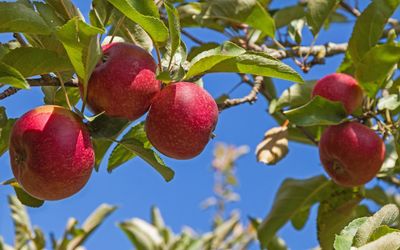About Zone 6 Apple Trees
There are over 2,500 apple varieties grown in the United States, so there’s bound to be one for you. Choose apple varieties that you like to eat fresh or are better suited to certain uses such as those for canning, juicing, or baking. Apples that are best eaten fresh are often referred to as “dessert” apples. Assess the amount of space you have for an apple tree. Realize that while there are a few apple varieties that do not require cross pollination, most do. This means that you will need to have at least two separate varieties for pollination in order to produce fruit. Two trees of the same variety will not cross pollinate each other. This means you need to have some space or select a self-pollinating variety, or choose dwarf or semi-dwarf cultivars. Some varieties, such as Red Delicious, are available in multiple strains which are mutations of a variety that has been propagated for a specific characteristic like fruit size or early ripening. There are over 250 strains of Red Delicious, some of which are spur-type. Spur-type apple trees have small short twigs with fruit spurs and leaf buds closely spaced, which reduces the trees size– another option for growers that are lacking in space. When purchasing zone 6 apple trees, get at least two different cultivars that bloom at the same time and plant them within 50 to 100 feet (15-31 m.) of each other. Crabapples are excellent pollinators for apple trees and if you already have one in your landscape or in a neighbor’s yard, you won’t need to plant two different cross pollinating apples. Apples need full sunlight for most or all of the day, particularly early morning sun which will dry the foliage thus reducing the risk of disease. Apple trees are unfussy regarding their soil, although they do prefer well-drained soil. Do not plant them in areas where standing water is a problem. The excess water in the soil doesn’t allow the roots access to oxygen and the result is stunted growth or even death of the tree.
Apple Trees for Zone 6
There are many options of apple tree varieties for zone 6. Remember, apple cultivars that are suited down to zone 3, of which there are several and will thrive in your zone 6. Some of the hardiest include:
McIntosh Honeycrisp Honeygold Lodi Northern Spy Zestar
Slightly less hardy varieties, suited to zone 4 include:
Cortland Empire Freedom Gold or Red Delicious Liberty Paula Red Red Rome Spartan
Additional apple cultivars suited to zones 5 and 6 include:
Pristine Dayton Akane Shay Enterprise Melrose Jonagold Gravenstein William’s Pride Belmac Pink Lady Ashmead’s Kernel Wolf River
And the list goes on….with:
Sansa Gingergold Earligold Sweet 16 Goldrush Topaz Prima Crimson Crisp Acey Mac Autumn Crisp Idared Jonamac Rome Beauty Snow Sweet Winesap Fortune Suncrisp Arkansas Black Candycrisp Fuji Braeburn Granny Smith Cameo Snapp Stayman Mutsu (Crispin)
As you can see, there are many apple trees well suited to growing in USDA zone 6.
